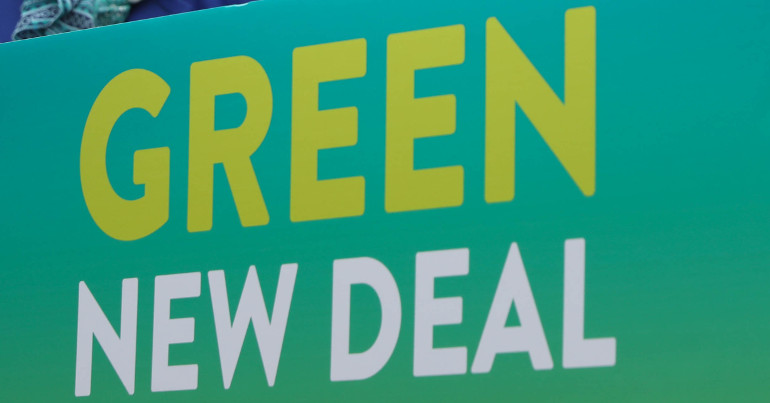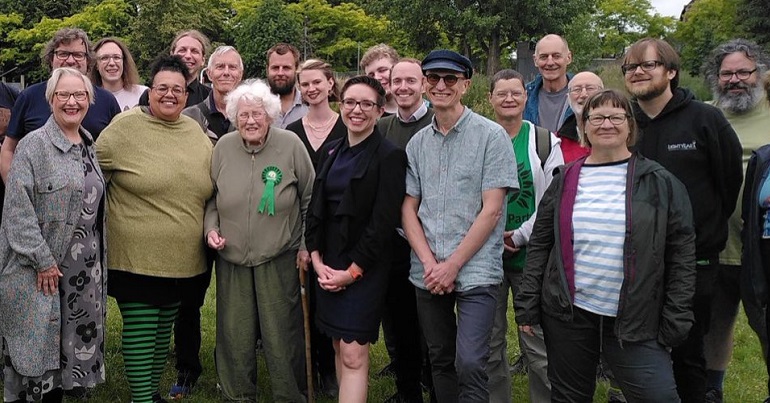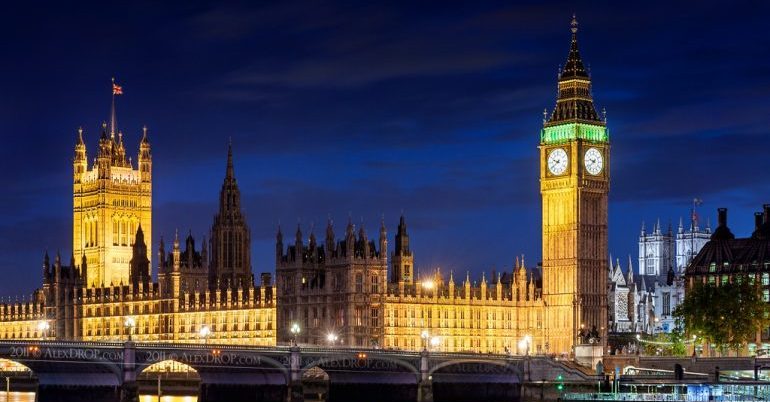A Green New Deal needs public abundance

The McDonald’s close to my apartment is closed. It’s a shame, because it was basically our neighbourhood’s most important social centre. Before Montreal went into lockdown, seniors spent whole days there chatting, youngsters would sip iced coffee, and others would sit behind laptops using the free wifi to write job applications.
Pretty much the whole neighbourhood was there. No one told people to leave, the coffee was affordable, and the bathroom was pretty clean. It wasn’t perfect. The police often came by, to remove homeless people trying to sleep or arrest those who hadn’t paid. Yet many spent their days there and looked forward to it as their main social interaction.
Previously for the Green European Journal, I argued that the Green New Deal needs people. Proposed as a far-reaching set of policies that would go beyond reform to transform the economy as we know it, the Green New Deal will only appeal to people if they can sense what it would mean for their everyday life. This article asks the reverse: why do people need the Green New Deal? Maybe counter-intuitively, I argue that the Green New Deal looks a lot like that closed McDonald’s: cheap, communal, universal basic resources for everyone who needs them.
A food library
The idea of a community or government-organised food service is often dismissed out of hand: likened to rationing or just plain communism.
The idea should not be brushed off so readily. McDonald’s are often the glue that holds communities together, as one Guardian headline put it. As the article’s author Chris Arnade says, unlike homeless shelters or other places of last resort, “McDonald’s are safer, provide more freedom, and most importantly, the chance to be social, restoring a small amount of normalcy.” Safety, freedom, a bit of normalcy, the chance to be social: not so different from the library. Because libraries are recognised as providing a necessary service to the community, no one would suggest replacing them with a for-profit franchise.
So imagine a kind of “food library”. Cheap, good food, a place to hang out, free wi-fi, endless coffee – everything would be the same, except it wouldn’t be run by a union-busting, unsustainable franchise. In many places, something much similar already exists. In Paris, students have access to “restos u”, cafeterias where a three-course meal costs 2.50 euros. In a city of sky-high rents and exorbitantly priced food marketed for tourists, it’s the only thing between many students and food insecurity. During World War II, British Restaurants, communal kitchens set up in 1940 to help people bombed out of their homes, served 600 000 very inexpensive meals a day.
In many countries around the world, at-cost cafeterias are already the norm in workplaces, schools, and universities: places to socialise and enjoy an affordable meal.
Libraries for everything
The same principle need not be limited to food. “Repair cafés” could be places to meet and relax in every neighbourhood, and where you can also learn how to fix appliances and gadgets, mend clothes, or maintain bicycles. Community tool libraries could allow you to borrow a drill for some DIY or a projector for your next neighbourhood film screening. Seed libraries, where you can take out seeds in the spring and deposit new ones at the end of the season or swap compost for ready-to-use soil, could help people get involved in growing food.
Cooperatively run car-sharing platforms like CommunAuto – which, when paired with good public transport, decrease the number of cars on the road – could replace polluting and traffic-creating services such as Uber and Lyft. In many Swedish towns, anyone with a library card can loan a cargo bike.
Many places already have such services, and many more places could too. The only thing stopping them from being more widely available is lack of political will, people power, and maybe a good dose of creative thinking.
Politicians, think tanks, and social movements are starting to put more concrete ideas of what the Green New Deal could look like on the table. What unites much of these proposals is that the Green New Deal would offer the necessities of life – housing, healthcare, education, transportation – for everyone.
These promises may seem, at first glance, to have little to do with the word “green”. How do access to healthcare and affordable housing make our world more sustainable? Who would pay for it? And why would we let the government control our lives to such a large extent?
The concept of public abundance answers these questions. While it new idea that is just beginning to be explored, public abundance may well be a basic requirement for building a more desirable future.
Universal basic services for the climate
The Green New Deal, in its various iterations, has involved proposals for free public transport, affordable housing, renewable energy in the hands of municipalities, free healthcare, childcare, and social care, and much more. Together, these fit under the concept “universal basic services”.
Universal public services are the less popular but potentially much smarter younger sibling of universal basic Income. Introduced in a 2017 report by the University College London’s Institute for Global Prosperity, the concept is based around the argument that the direct provision of services would be much more effective in achieving wellbeing than basic income. The necessities of life can, and should, be made available to everyone.
Rolling out universal basic services, as well as meeting essential needs, makes it easier for everyone to live sustainably. Growing the caring sector helps us switch from an economy that relies on both bullshit and batshit jobs – respectively, jobs which are pointless and unfulfilling and jobs that make the planet a more dangerous place to live – to an economy that prioritises low-carbon care work. Accessible public transport, including expanding electric bus coverage into the countryside, provides alternatives to driving and flying, instead of shaming people for doing so.
The right to housing is also a key pillar of the Green New Deal. Building dense, livable neighborhoods means less expenditure per person on heating, transportation, and electricity. But this only holds true when cities are accessible for working-class people and offer shared resources for sustainable consumption. For example, as Daniel Aldana Cohen’s research shows, the New York City boroughs of Manhattan and Queens are much denser than most cities in the United States. But people in Manhattan – mostly wealthy – have a far higher carbon footprint than just about anyone else in the world due to their high-income, unsustainable lifestyles. In comparison, people in the poorer neighbourhood of Queens have a very low carbon footprint. Dense neighbourhoods are greener, but only when they are affordable places to live.
A Green New Deal that supports repair cafés, green spaces in every municipality, low-cost cafeterias open to all, libraries, and even theatres promises to make daily life not just more livable but more enjoyable too. Showing that zero carbon can mean more free time for friends, community spaces, and new hobbies counters the idea that we live in a world of limits and scarcity. In short, as part of a big package, universal basic services bring ecological living to everyone, not just those who can afford it.
Another empty promise?
Universal basic services are not just an empty promise. Through a Green New Deal, they build on the public services already available in much of the world. Different cities and countries are already experimenting with free public transport. Many countries also offer free healthcare, education, school lunches, and affordable housing. In Vienna, one third of the city lives in public housing, as the authors of the book A Planet to Win: Why we need a Green New Deal observe. Another third of the city’s housing stock are cooperatives. The rest is, in great part, affordable private housing. The city also charges just 1 euro per day for public transit, and childcare is free for children under eight.
There are many more possibilities to experiment with. In Morocco, many neighbourhoods have a communal oven so that every family can bake their own bread. Using a communal oven means that people can keep their own home cool, save on fuel costs, and use less energy overall.
Small changes can transform a whole system. After Thiruvananthapuram, the capital city of the state of Kerala, India, had to close its only municipal landfill site in 2011, they developed a new policy of decentralised, efficient, community-run waste management in every area – eventually helping to reduce 67 per cent of the city’s waste production. Thiruvananthapuram’s innovative way of approaching municipal waste shows that citizens, when given the tools, can take ecological living into their own hands.
In Montreal, Canada, the city recently started a programme giving free soil and small funds to any group of residents who wants to turn their street into a “green alley”. If combined with social housing and caps on real estate speculation, these kinds of programmes could ensure that “green” cities do not have to be exclusive for the rich.
Today, many groups – from social movements and political parties to think tanks and research institutes – are piecing together how these disparate initiatives at the local level can fit into the Green New Deal. The Green New Deal for Europe campaign, Alexandria Ocasio-Cortes’ Green New Deal proposal, and think tanks like the UK’s Common Wealth all offer public ownership of basic services as a key aspect of their proposals.
The authors of A Planet to Win emphasise the importance of the expansion of energy cooperatives, investment in culture, and creativity for shifting to a green, sustainable, and caring economy [for more from A Planet to Win authors Alyssa Battistoni and Daniel Aldana Cohen, see this interview]. More practically, organisations such as the Next System Project and the New Economy Coalition have focused on innovative alternatives to a for-profit economy, filling in the details of what local, public abundance could potentially look like.
Is the Green New Deal communism?
Many people may object that these programmes will be overly bureaucratic and depend on central planning and taxes. Critics of the Green New Deal, especially those in North America, dismiss it as a wish list for the communist left. But if it is to be successful, the Green New Deal should be about more democracy, not less. From cooperative housing to publicly owned energy grids, these proposals are about taking both the profit motive and the disempowering arm of the state outside of everyday life.
There is also the idea that public services are necessarily poorer quality, and that the market can do it better. Yet consider the landmark new book by the Trans-National Institute, which traces 1400 cases where private services have been “remunicipalised” and brought back under local government control. As they document, democratic public ownership is often more efficient, transparent, and sustainable.
Part of this criticism is also a hangover from the Cold War when Soviet communism and American capitalism seemed to be the only models of government around. But this binary starts falling apart when one looks at experiences of democratic socialism in Scandinavia, ecological communism in Cuba, the economie sociale in Quebec, and new kinds of democratic planning in places like Kerala, India and Costa Rica. As George Monbiot points out, the future could be neither state communist nor capitalist. It could be something new. It’s hard to imagine something that has never been experienced, but why should it look exactly like the past?
A common reaction to universal basic services and the Green New Deal is to ask who will pay for it. The answer is that there are plenty of options: taxes on high earners and polluting firms, financing by central banks, cutting military expenditure, and long-term returns on investment in green infrastructure. The real issue is political will. Just think about the impressive government policies put in place in the span of weeks when the coronavirus pandemic hit. This crisis has shown us that, when it comes down to it, the money is there.
Public abundance
Underlying different Green New Deal proposals is “public abundance”. Some, like the authors of A Planet to Win, call it “communal luxury”. The think tank Common Wealth refers to it as “public luxury”. Others still call it “luxury communism”.
But the meaning of luxury is that some have it and others do not. As French theorist André Gorz put it, “the essence of luxury is that it cannot be democratised. If everyone can have luxury, no one gets any advantages from it.” The point of the Green New Deal should be to create ways of life that break free from everyday scarcity. This vision is not one of extravagance but of meeting the basic necessities of life, and having plenty to go around, for everyone.
To make this happen, political parties need to show, not tell, what this will be like. Any party advocating the Green New Deal should work closely with willing and interested municipal governments to implement radical transformations in daily life, allowing people to see what is possible. Pilot repair cafés in one neighbourhood, or a system of childcare cooperatives in a whole city. These examples can become models that build up wider support.
Returning to the McDonald’s near my apartment, it was not a luxury for those elderly people spending their days there chatting with friends: just a pleasant way to spend the day. Why shouldn’t everyone have access to that? Why shouldn’t communities own and run places like that for themselves?
That would look a lot like a world of abundance, where leisure and a good life is not a luxury but a right. And it is not that far away. It already exists, in small fragments, everywhere. The Green New Deal is about piecing them together.
This article was first published in the Green European Journal – Europe’s leading political ecology magazine offering green & progressive ideas and analysis offered by thinkers like Caroline Lucas, Yanis Varoufakis, Ann Pettifor, and Vandana Shiva.
PS. We hope you enjoyed this article. Bright Green has got big plans for the future to publish many more articles like this. You can help make them happen. Please donate to Bright Green now.
Image credit: Senate Democrats – Creative Commons




There is nothing intrinsically wrong with money as part of the process of the exchange of goods and services. It is a huge step forward from barter.
What is wrong is the stupendously unequal distribution of wealth between continents and countries, and within countries, without an effective world government, whilst the global rich operate very effectively to run everything in their interests.
Universal Basic Income, IF THE LEVEL SET IS HIGH ENOUGH AND COMBINED WITH PROGRESSIVE TAXATION, is the best mechanism I have encountered that could be the best way forward. It has the possibility of getting mass support. Let’s all get behind this and concentrate on it, place it at the centre of radical politics, and be wary of the experiences outlined in the article, not because they are intrinsically wrong, but they are a good recipe for keeping redical politics marginalised at the fringes of society.